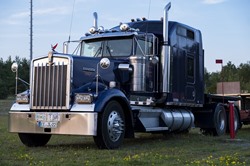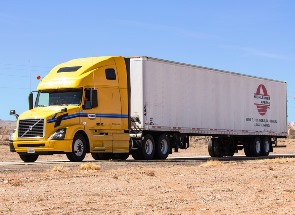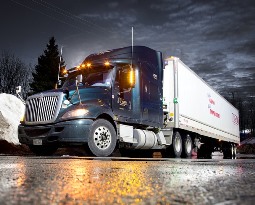How to Find the Right CDL Driving Classes near Trail Oregon
 Congratulations on your decision to become a trucker and enroll in a truck driving school near Trail OR. Maybe it has always been your dream to hit the open road while operating a monster tractor trailer. Or perhaps you have done some research and have discovered that a career as a truck driver provides good pay and flexible job prospects. No matter what your reason is, it’s imperative to obtain the proper training by enrolling in the right CDL school in your area. When assessing your options, there are certain factors that you’ll want to consider before making your ultimate selection. Location will certainly be an issue, especially if you have to commute from your Trail residence. The cost will also be important, but selecting a school based entirely on price is not the best method to make sure you’ll obtain the appropriate education. Don’t forget, your goal is to master the knowledge and skills that will allow you to pass the CDL examinations and become a qualified truck driver. So keeping that objective in mind, just how do you decide on a truck driving school? That is what we are going to cover in the remainder of this article. But first, we are going to discuss a little bit about which CDL license you will ultimately need.
Congratulations on your decision to become a trucker and enroll in a truck driving school near Trail OR. Maybe it has always been your dream to hit the open road while operating a monster tractor trailer. Or perhaps you have done some research and have discovered that a career as a truck driver provides good pay and flexible job prospects. No matter what your reason is, it’s imperative to obtain the proper training by enrolling in the right CDL school in your area. When assessing your options, there are certain factors that you’ll want to consider before making your ultimate selection. Location will certainly be an issue, especially if you have to commute from your Trail residence. The cost will also be important, but selecting a school based entirely on price is not the best method to make sure you’ll obtain the appropriate education. Don’t forget, your goal is to master the knowledge and skills that will allow you to pass the CDL examinations and become a qualified truck driver. So keeping that objective in mind, just how do you decide on a truck driving school? That is what we are going to cover in the remainder of this article. But first, we are going to discuss a little bit about which CDL license you will ultimately need.
Which Commercial Drivers License Should You Get?
 To drive commercial vehicles legally within the United States and Trail OR, an operator must attain a CDL (Commercial Driver’s License). The three license classes that one can apply for are Class A, Class B and Class C. Given that the topic of this article is how to choose a truck driving school, we will discuss Class A and B licenses. What differentiates each class of CDL is the kind of vehicle that the driver can operate together with the GVWR (Gross Vehicle Weight Rating) or GCWR (Gross Combination Weight Rating). Below are short explanations for the two classes.
To drive commercial vehicles legally within the United States and Trail OR, an operator must attain a CDL (Commercial Driver’s License). The three license classes that one can apply for are Class A, Class B and Class C. Given that the topic of this article is how to choose a truck driving school, we will discuss Class A and B licenses. What differentiates each class of CDL is the kind of vehicle that the driver can operate together with the GVWR (Gross Vehicle Weight Rating) or GCWR (Gross Combination Weight Rating). Below are short explanations for the two classes.
Class A CDL. A Class A Commercial Drivers License is required to drive any vehicle that has a GCWR of greater than 26,000 lbs., including a towed vehicle of greater than 10,000 lbs. Some of the vehicles that operators may be able to drive with Class A licenses are:
- Interstate or Intrastate Tractor Trailers
- Trucks with Double or Triple Trailers
- Tanker Trucks
- Livestock Carriers
- Class B and Class C Vehicles
Class B CDL. A Class B Commercial Drivers License is required to operate single vehicles having a GVWR of more than 26,000 lbs., or a GCWR of greater than 26,000 lbs. including a towed vehicle weighing up to 10,000 lbs. Some of the vehicles that operators may be qualified to drive with Class B licenses are:
- Tractor Trailers
- Dump Trucks
- Cement Mixers
- Large Buses
- Class C Vehicles
Both Class A and Class B Commercial Drivers Licenses might also need endorsements to drive certain kinds of vehicles, including school or passenger buses. And a Class A license holder, with the appropriate required endorsements, may operate any vehicle that a Class B licensee is authorized to drive.
Click Here to Get Free Information on Truck Driving Schools Near You!
How to Assess a Truck Driver School
 Once you have determined which Commercial Drivers License you want to obtain, you can begin the process of assessing the Trail OR truck driving schools that you are looking at. As previously discussed, location and cost will undoubtedly be your primary considerations. But it can’t be stressed enough that they should not be your only considerations. Other issues, for instance the experience of the instructors or the reputations of the schools are equally if not more important. So following are some additional things that you should research while conducting your due diligence before selecting, and particularly paying for, your truck driving training.
Once you have determined which Commercial Drivers License you want to obtain, you can begin the process of assessing the Trail OR truck driving schools that you are looking at. As previously discussed, location and cost will undoubtedly be your primary considerations. But it can’t be stressed enough that they should not be your only considerations. Other issues, for instance the experience of the instructors or the reputations of the schools are equally if not more important. So following are some additional things that you should research while conducting your due diligence before selecting, and particularly paying for, your truck driving training.
Are the Schools Accredited or Certified ? Not many trucking schools in the Trail OR area are accredited due to the rigorous process and expense to the schools. On the other hand, certification is more common and is provided by the Professional Truck Driver Institute (PTDI). A school is not obligated to become certified, but there are a number of advantages. Interested students know that the training will be of the highest standard, and that they will be given plenty of driving time. For example, PTDI calls for 44 hours of real driving time, not simulations or ride-alongs. So if a school’s program is certified (the program, not the school is certified), students know that the training and curriculum will measure up to the very high standards set by PTDI.
How Long in Operation? One clue to help assess the quality of a truck driver school is how long it has been in operation. A negatively reviewed or a fly by night school usually will not stay in business very long, so longevity is a plus. On the other hand, even the best of Trail OR schools had to begin from their first day of training, so consider it as one of multiple qualifications. You can also find out what the school’s track record is concerning successful licensing and job placement of its graduating students. If a school won’t supply those numbers, search elsewhere. The schools should also maintain relationships with local and national trucking companies. Having numerous contacts not only affirms a superior reputation within the profession, but also boosts their job placement program for graduates. It also wouldn’t be a bad idea to check with the Oregon licensing authority to make sure that the CDL trucker schools you are reviewing are in compliance.
How Effective is the Training? As a minimum requirement, the schools must be licensed in Oregon and employ teachers that are trained and experienced. We will discuss more about the teachers in the following section. Also, the student to instructor ratio should not be greater than 4 to 1. If it’s any higher, then students will not be obtaining the individual attention they will need. This is especially true regarding the one-on-one instruction for behind the wheel training. And be critical of any school that professes it can teach you to drive trucks in a comparatively short time period. Training to be a truck driver and to drive a tractor trailer skillfully requires time. The majority of Trail OR schools provide training courses that run from 3 weeks to as long as 2 months, depending on the license class or type of vehicle.
How Experienced are the Teachers? As previously stated, it’s important that the instructors are qualified to teach driving techniques and experienced as both instructors and drivers. Although a number of states have minimum driving time prerequisites to qualify as an instructor, the more professional driving experience a teacher has the better. It’s also crucial that the teachers keep current with industry advancements or any new laws or changes in regulations. Assessing teachers may be a little more subjective than other criteria, and perhaps the best method is to visit the school and talk to the instructors face to face. You can also talk to some of the students going through the training and find out if they are happy with the level of instruction and the teacher’s ability to train them.
Adequate Driving Time? Above all else, an excellent trucking school will furnish lots of driving time to its students. Besides, isn’t that what it’s all about? Driving time is the actual time spent behind the wheel driving a truck. Although the use of simulators and ride-a-longs with other students are necessary training methods, they are no alternative for actual driving. The more training that a student gets behind the wheel, the better driver he or she will become. And even though driving time can vary between schools, a reasonable benchmark is a minimum of 32 hours. If the school is PTDI certified, it will furnish no less than 44 hours of driving time. Get in touch with the Trail OR schools you are considering and ask how much driving time they furnish.
Are they Captive or Independent ? You can get free or discounted training from certain trucking schools if you enter into an agreement to drive for a specified carrier for a defined amount of time. This is what’s known as contract training, and the schools that provide it are called captives. So instead of maintaining relationships with a wide range of trucking lines that they can place their graduates with, captives only refer to one company. The benefit is receiving less expensive or even free training by surrendering the freedom to initially work wherever you have an opportunity. Obviously contract training has the potential to reduce your income prospects when starting out. But for many it may be the best way to obtain affordable training. Just make sure to find out if the Trail OR schools you are considering are captive or independent so that you can make an informed decision.
Is there Onsite CDL Testing? There are some states that will allow 3rd party CDL testing onsite of truck driving schools for its graduates. If onsite testing is permitted in Oregon, find out if the schools you are looking at are DMV certified to provide it. One benefit is that it is more accommodating than competing with graduates from competing schools for test times at Oregon testing locations. It is moreover an indicator that the DMV views the approved schools to be of a superior quality.
Are the Class Times Convenient? As previously noted, truck driving training is only about 1 to 2 months long. With such a short term, it’s important that the Trail OR school you select provides flexibility for both the curriculum and the scheduling of classes. For example, if you’re having difficulty learning a certain driving maneuver, then the teacher should be prepared to commit more time with you until you have it mastered. And if you’re still employed while going to training, then the class scheduling needs to be flexible enough to fit in working hours or other commitments.
Is Job Placement Offered? The moment you have received your CDL license after graduating from truck driver school, you will be keen to begin your new profession. Confirm that the schools you are considering have job placement programs. Ask what their job placement rate is and what average salary their grads start at. Also, find out which national and local trucking firms their graduates are placed with for employment. If a school has a poor job placement rate or few Trail OR employers recruiting their grads, it might be a sign to search elsewhere.
Is Financial Assistance Offered? Trucking schools are comparable to colleges and other Trail OR area trade or technical schools when it comes to loans and other forms of financial aid being offered. Find out if the schools you are assessing have a financial assistance department, or at least someone who can help you navigate the options and forms that need to be submitted.
Best Truck Driving School Trail Oregon
 Picking the ideal truck driving school is an important first step to starting your new vocation as a long distance or local truck driver. The skill sets that you will learn at school will be those that forge a new career behind the wheel. There are a number of options offered and understanding them is vital to a new driver’s success. You originally came to our website because of your interest in Best Truck Driving School and wanting information on the topic CDL School Cost. However, you must receive the proper training in order to operate a big commercial vehicle in a professional and safe fashion. If you are short on funds or financing, you might need to look into a captive school. You will pay a lower or in some cases no tuition by agreeing to drive for their contracted carrier. Or you can enroll in an independent CDL school and have the option of driving for the trucking company of your choice, or one of many affiliated with the school. It’s your choice. But no matter how you get your training, you will in the near future be part of an industry that helps America move as a professional trucker in Trail OR.
Picking the ideal truck driving school is an important first step to starting your new vocation as a long distance or local truck driver. The skill sets that you will learn at school will be those that forge a new career behind the wheel. There are a number of options offered and understanding them is vital to a new driver’s success. You originally came to our website because of your interest in Best Truck Driving School and wanting information on the topic CDL School Cost. However, you must receive the proper training in order to operate a big commercial vehicle in a professional and safe fashion. If you are short on funds or financing, you might need to look into a captive school. You will pay a lower or in some cases no tuition by agreeing to drive for their contracted carrier. Or you can enroll in an independent CDL school and have the option of driving for the trucking company of your choice, or one of many affiliated with the school. It’s your choice. But no matter how you get your training, you will in the near future be part of an industry that helps America move as a professional trucker in Trail OR.
Truck On in These Other Oregon Locations
Trail
A trail is usually a path, track or unpaved lane or road. In the United Kingdom and the Republic of Ireland path or footpath is the preferred term for a walking trail. The term is also applied, in North America, to routes along rivers, and sometimes to highways. In the US, the term was historically used for a route into or through wild territory used by emigrants (e.g. the Oregon Trail). In the USA "trace" is a synonym for trail, as in Natchez Trace. Some trails are single use and can only be used for walking, cycling, horse riding, snowshoeing, and cross-country skiing; others, as in the case of a bridleway in the UK, are multi-use, and can be used by walkers, cyclists and equestrians. There are also unpaved trails used by dirt bikes and other off-road vehicles and in some places, like the Alps, trails are used for moving cattle and other livestock.
In New Zealand, the terms track or walkway are used almost exclusively except in reference to cross-country skiing: "walkways vary enormously in nature, from short urban strolls, to moderate coastal locations, to challenging tramps [hikes] in the high country [mountains]".[1] Walkway is used similarly in St. John's, Newfoundland, Canada, where the "Grand Concourse", is an integrated walkway system.[2]
In the United Kingdom, the term trail is in common usage. Longer distance walking routes, and government-promoted long distance paths, collectively known as National Trails, are also frequently called ways; as in the Pennine Way and South Downs Way. Generally the term footpath is preferred for pedestrian routes, including long distance trails, and is also used for urban paths and sometimes in place of pavement. Track is used for wider paths (wide enough for vehicles), often used for hiking. The terms bridleway, byway, restricted byway are all recognised legal terms and to a greater or lesser extent in general usage.
Business Results 1 - 10 of 7







